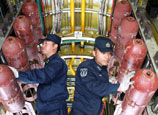
LANZHOU, July 27 (Xinhua) -- A high-speed railway that will enable passengers to travel the 1,900 km between the northwest Chinese cities of Lanzhou and Urumqi in eight hours upon completion in 2014 has been hailed for the trade boost it will bring.
The line has been dubbed a "high-speed Silk Road" for the role it will play in transporting goods and people along the historical network of trade routes which still play such a huge part in local commerce. In ancient times, it would have taken two months on camel-back to traverse the branch between the cities now known as Lanzhou and Urumqi.
"It feels like a time warp," says Wu Hanfei, an engineer with the high-speed railway construction project.
Wu came to the construction site at Gaotai County in Zhangye City, Gansu Province, in June 2010 to join thousands of workers.
In his spare time, Wu would look at a nearby railway track which opened to traffic in 1962. The track immediately became important for its ability to shuttle passengers from Lanzhou to Urumqi in 20 hours, and it will continue to operate.
When the new railway opens to traffic in October next year, however, the high-speed line will mostly serve passenger trains while the old one will serve cargo trains. At that point, the old railway will be freed up to transport 424 million tonnes of goods annually, twice as many as at present.
"This will significantly improve the transport capacity in northwest China," says Wu Tianyun, head of the Lanzhou Railway Bureau.
In ancient times, the tough travel conditions made journeying west a painful decision. It was often a one-way trip, with many people finding it impractical to return to the Central Plains.
The new railway will be linked to the country's railway network from Lanzhou after operation. Traveling from Beijing to Urumqi, which are more than 3,000 km apart, will take less than one day.
"By then, traveling west will be enjoyable for people living in central and eastern China, once the ancient Central Plains, because they will get to see historical relics, beautiful scenery, and exotic tradition without fearing they can never come back," says Wu Tianyun.
Cutting the journey time from months to hours, the high-speed Silk Road will change not only people's ways of traveling, but also northwest China's economic structure.
Starting from the ancient city of Chang'an, now known as Xi'an, the Silk Road extends to the Mediterranean region in the west and the Indian subcontinent in the south. Its total length is over 10,000 km, with 4,000 km located within China.
The cities now known as Lanzhou, Dunhuang, and Urumqi are all important stops on the route.
While silk continues to be the key trade good, agriculture, tourism, and the new energy and logistics industries have all boomed along the present-day Silk Road.
In the first four months of 2013, Dunhuang, which holds historical relics relating to the early Silk Road, received 750,000 tourists and a total revenue of 690 million yuan (112.5 million U.S. dollars).
And Wei Zhizhong, director of the Dunhuang Tourism Bureau, predicts, "After the operation of the high-speed railway, we'll see skyrocketing numbers of tourists."
While tourists are an important commodity traveling predominantly east to west along this route, grapes are a big deal going in the other direction.
The fruit used to be restricted largely to west China, with only wealthy families in the Central Plains able to afford it. Nowadays, more than 100,000 tonnes of grapes are transported each year from Dunhuang to central and east China. Some 120,000 mu (8,000 hectares) of land in Dunhuang are dedicated to growing the juicy orbs, and this is expected to expand.
"In ancient times, it would take 5,000 camels walking nearly two months to transport 100,000 tonnes of grapes from the west to central and eastern China," explains Niu Xinjun, a farmer in Qili County of Dunhuang.
In fact, wherever one looks along the Silk Road there are foundations for healthy growth that the new railway will surely build upon. While the Gobi Desert used to mean toil and death, everything seems lively today.
In the suburbs of Yumen City in Gansu, 1,100 wind towers stand along 40 km of desert. Enterprises are transporting steel and iron through railways to Yumen and building bases for new energy and manufacturing industries.
"By 2015, annual sales for these industries will reach 15 billion yuan," beams Yumen mayor Song Cheng.
















 Working under 40 degrees Celsius
Working under 40 degrees Celsius


![]()
